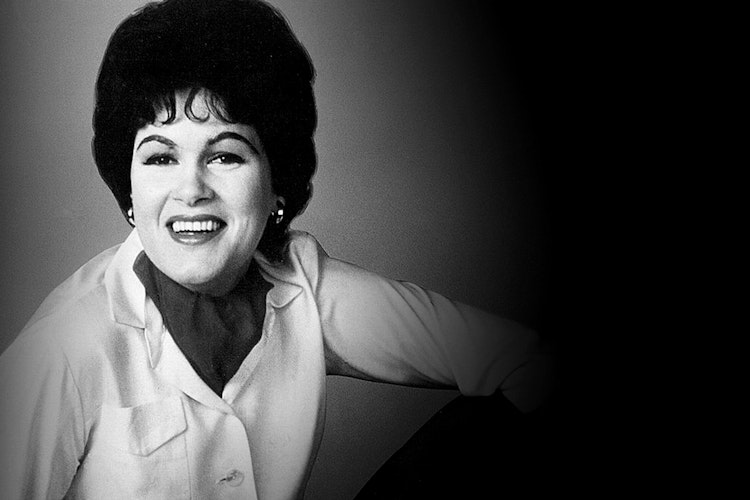In part 1 of this series, we will celebrate female artists from multiple decades who were, and still are, influential in shaping music as we know it.
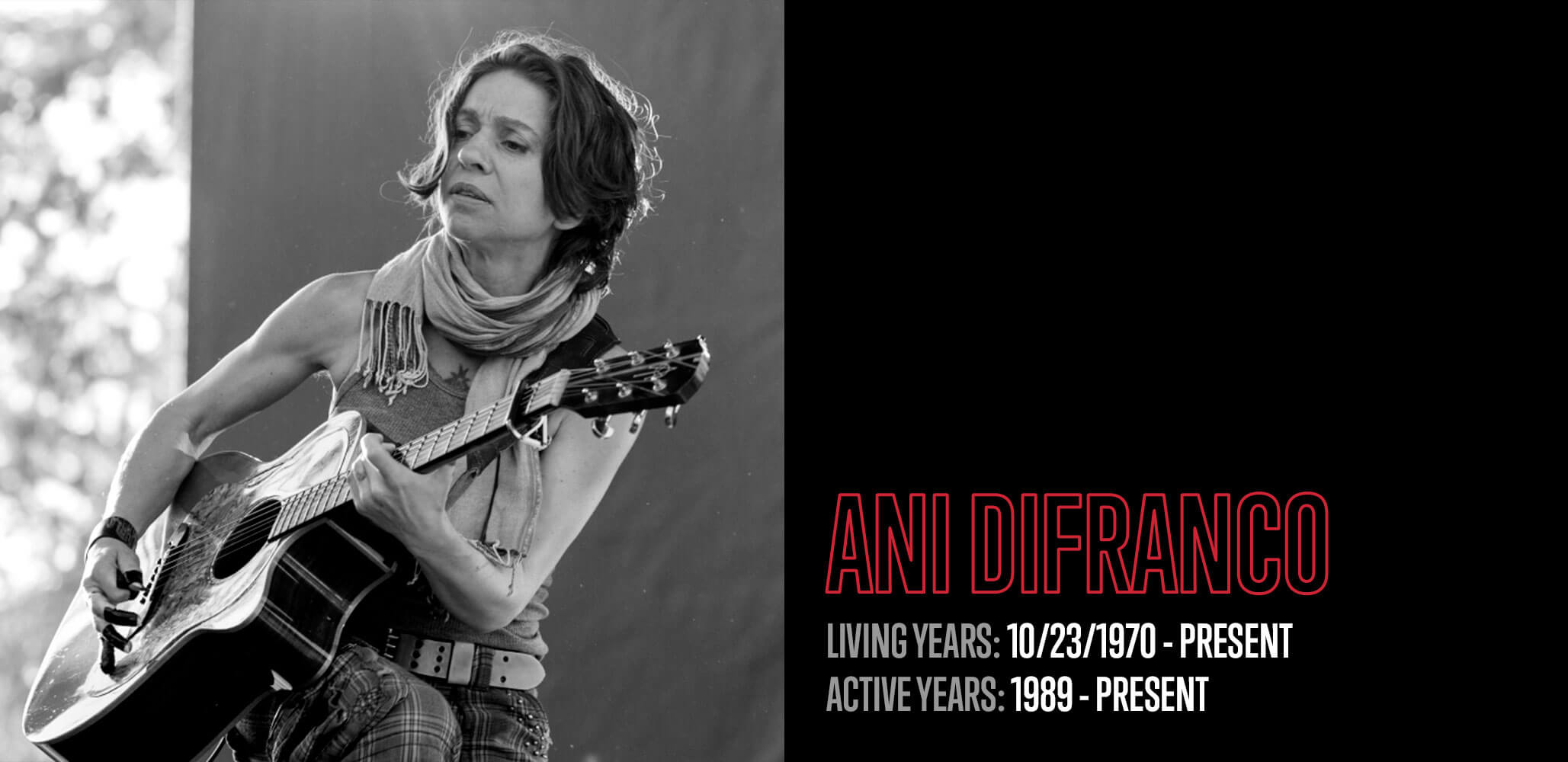
INSTRUMENTS
Acoustic Guitar, Voice, Pen
GENRES
Folk, Punk, Alternative, Hip-Hop, Funk, Indie, Spoken-Word Poetry
NOTABLE SONGS
Both Hands, 32 Flavors, Untouchable Face, Shameless
ASSOCIATED ARTISTS
Pete Seeger, Utah Phillips, Prince, Maceo Parker, Cyndi Lauper, Woody Guthrie
BIOGRAPHY
Self-made, outspoken, and passionate are a few of the ways to describe the very busy and multi-talented Ani (Angela Maria) DiFranco who has been pursuing her music path since she was 9 years old, busking with her guitar teacher in her hometown of Buffalo, NY. By 14 she was songwriting and she became an emancipated minor at age 15, allowing her to make music and performance her focus. She has been touring and releasing recordings ever since starting her own record company, Righteous Babe Records, in 1989 at the age of 19. She moved to New York City, took poetry classes, shaved her head, and sold her first, self-titled release on cassette out of her trunk by 20. During a fifteen-year period of touring through colleges and women’s organizations across the U.S.A. and propelled by word-of-mouth, her popularity reached national and international acclaim in the 1990s. Ani glossed magazine covers, rang out in movie soundtracks, and shone through in her music, spoken-word and acting performances on TV, and all punctuated with songs like “Both Hands” (the first song of her first album), “32 Flavors” (later covered by Alana Davis), and “Gravel”. Dilate, her critically best album came out in 1996 and had success with songs like “Untouchable Face”, “Shameless” (a ‘coming out’), and “Joyful Girl”.
Ani is first and foremost a social and political activist and conveys this through her poetic lyrics which are increasingly punny, sophisticated, and incisive. Music is her conduit and her autobiographical advocacy continues to highlight social issues like gender and sexual identity and abuse, reproductive rights, racial equality, and poverty. She started her non-profit organization, Righteous Babe Foundation in 1999, a year that was overflowing with a new (second) Utah Phillips collaborative album, and a tour with saxophone great Maceo Parker in her band during which they both met Prince (this meeting later resulted in collaborative albums from all three.). Her raw determination and perseverance are reflected in her iconic posture on the Righteous Babe emblem that is stamped on her many accomplishments and organizations, including a large concert venue and contemporary arts center affectionately called “Babeville” which opened in 2006 in Buffalo. That same year Ms. DiFranco received the Woman of Courage Award from the National Organization for Women (NOW). She has been privileged to work with legends and mentors like Bruce Cockburn, Pete Seeger, Sekou Sundiata, Nona Hendryx, and Cyndi Lauper. As early as 1995, she began contributing to the Woody Guthrie Foundation and Archives and Rock and Roll Hall of Fame Museum, and in 2009 DiFranco received the Woody Guthrie Award for being a voice of positive social change. Since 2008 she has drawn inspiration from a list of New Orleans-based horn players in her Bywater, Louisiana home with her producer/engineer husband and two children.
Reviewers have described Ani’s music in many ways-- Folk, Punk, Alternative, Rap, Jazz, and Indie, and while all show their influence in her recordings, she is the very definition of a Rock Troubadour. DiFranco has said of ‘folk’: "It's an attitude, it's an awareness of one's heritage, and it's a community." Folk-Punk may be the closest we come to a genre to explain her alto, syncopated, slam-poet-like delivery of strikingly vulnerable lyrics layered with her bursting acoustic guitar’s grass roots’ tunings (allowing her to provide her own bass line) and fast fingerpicking. Although her passionate signature style has continued to mature over her now 22+ album catalog (with titles like Not So Soft and Binary), 2 books of poetry (Self Evident, Verses), countless collaborations and benefit concerts, and in her memoir (No Walls and the Recurring Dream 2019), she excels at being truly intimate and honest with her audience. Describing herself as ‘queer’, her vast network was built through personal connections and creative freedom in action. She is a groundbreaking independent label owner who produced artists like Anais Micthell, That 1 Guy, Erin McKeown, Andrew Bird, and Margaret Cho, and who joined Prince in openly discussing the problems of major record companies. DiFranco's musical accolades include a gold record for her 1998 double live album Living in Clip and a Grammy Award for Best Recording Package in 2004 for Evolve.
ARTISTS/ACTS THEY INFLUENCED
Alana Davis, Anais Mitchell, Peter Mulvey, Erin McKeown, Andrew Bird

INSTRUMENTS
Vocalist, piano, organ
GENRES
Blues, Gospel, R&B, Jazz, Rock
NOTABLE SONGS
Respect, Think, (You Make Me Feel Like) A Natural Woman, Amazing Grace, Chain of Fools, Bridge Over Troubled Water
BIOGRAPHY
Known as the “Queen of Soul,” Aretha Louise Franklin was born in Memphis, Tennessee, and raised in Detroit, Michigan. Her father was a well-known Baptist preacher and her mother was a gospel singer. Aretha grew up singing gospel music with her sisters. Aretha’s father’s popularity led to many celebrities visiting them. Musicians and religious leaders such as Clara Ward, James Cleveland, Albertina Walker, Martin Luther King Jr., Jackie Wilson and Sam Cooke all were close to the family.
The tragedies she experienced throughout her life were reflected in her music. Aretha sang from her heart. Aretha had many influences on her music. She was heavily influenced by Clara Ward and Mahalia Jackson, who cared for her after her mother’s death when she was 10 years old. She also admired the up and coming Motown artists; Doo Wop artists such as The Platters, The Drifters, The Clovers, Frankie Lymon, Jackie Wilson, Ruth Brown, Little Richard, Church Berry, Fats Domino, BB King and others. In turn, her career influenced countless artists.
“Aretha influenced everybody… Rock and Roll, Soul, Jazz. There were so many lessons to be learned from Aretha: In rhythm, in control, in how and when to embellish the melody and, even more importantly, when not to. And in life: She stood up.” - Benmont Tench, keyboardist for Tom Petty & The Heartbreakers
Some of her soulful hits like “Respect” served as a template for contemporary Rock and Roll artists who recorded out of the Muscle Shoals recording studio in the 60s and beyond. The powerful messages in her songs subliminally set the standard for Rock and Roll music.
Aretha got her start singing Gospel music but managed to also express Black musical traditions by blending Jazz, R&B and Blues. And somehow Gospel always found its way back into her music.
The Soul Queen “took you to church even if she was singing about a no-good man,” - Candi Staton, singer.
Aretha passed away in her home in Detroit in 2018 at the age of 76.
Aretha has been honored with many awards in recognition of her incredible career. She was the first woman inducted into the Rock and Roll Hall of Fame in 1987. She won an incredible 18 Grammy awards throughout her career including a Grammy Legend Award in 1991 and a Grammy Lifetime Achievement award in 1994. She was also awarded the Presidential Medal of Freedom in 2005.
TECHNICAL INNOVATIONS
During her time with Columbia Records (1960-65) Aretha was introduced to new recording technology, multi-tracking, that allowed her to personally sing and play several parts of the song.
HISTORICAL OR CULTURAL CONTEXT
Queen of Soul
ARTISTS/ACTS SHE INFLUENCED
Beyoncé, Jennifer Hudson, Adele, Dolly Parton, Tammy Wynette, and countless others
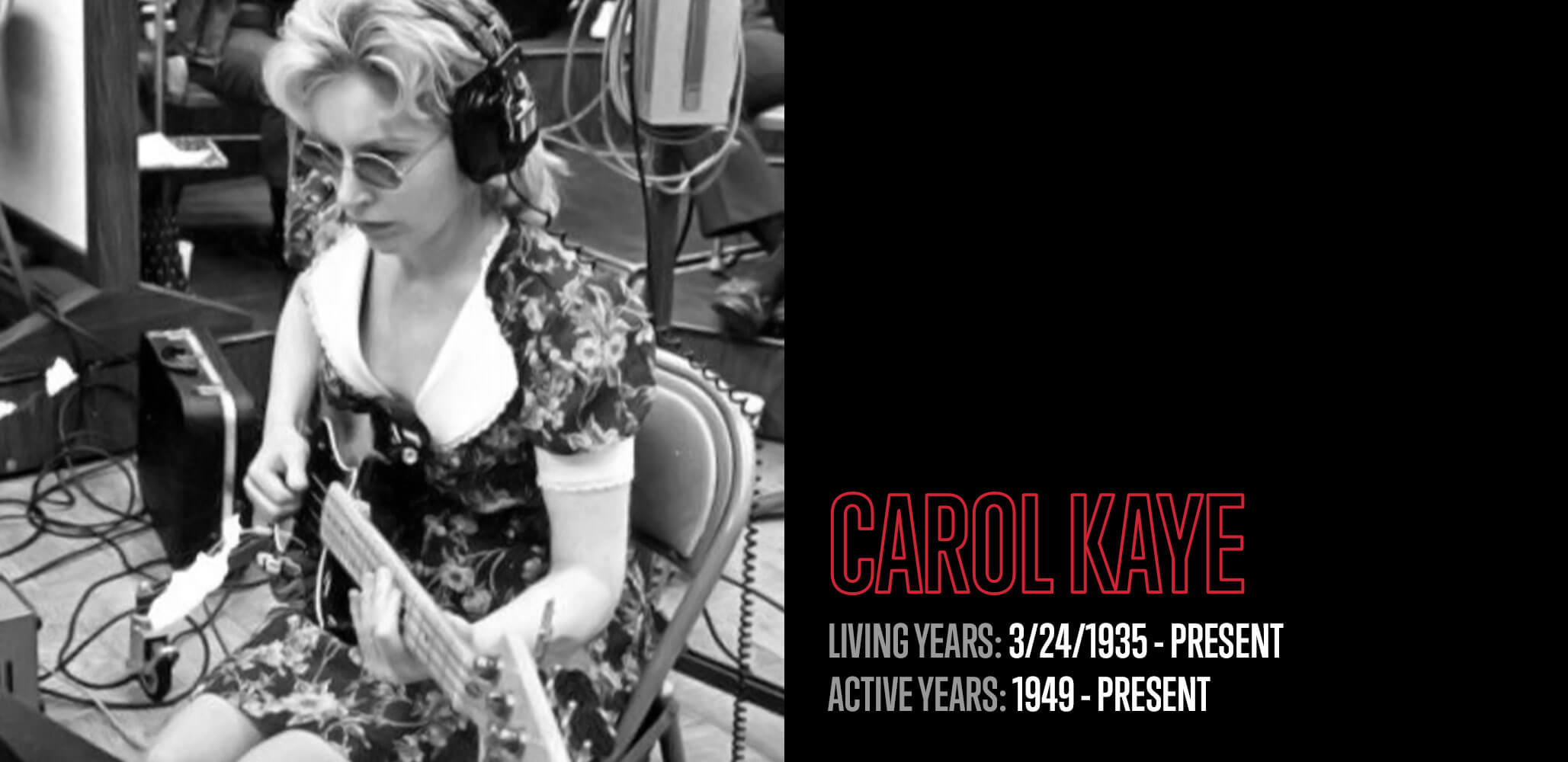
INSTRUMENTS
Guitar, Electric Bass, Banjo
GENRES
Jazz, Soul, Pop, R&B, Rock
NOTABLE SONGS
You’ve Lost That Lovin’ Feelin’, I Got You Babe, I’m a Believer, These Boots Are Made for Walking
BIOGRAPHY
Carol Kaye is one of the most accomplished session musicians of all time and is nothing less than a legend. If you’ve heard a Soul, Pop, R&B, or Classic Rock song from the 60s or early 70s, chances are you’ve heard Carol Kaye. Born in 1935 in Everett, Washington, Kaye was primarily influenced musically by her parents Clyde and Dot Smith. Clyde played trombone with Vaudeville acts and Big Bands and Dot was a pianist for silent movie houses. After moving to California as a young teenager, Carol found it difficult to find herself until a guitar salesman came around in 1948. “For ten bucks, you could learn to play the steel guitar.” Carol excelled at her new instrument and by age 14, she was playing gigs in jazz clubs near her home. While Kaye is most known for her bass playing skills, she has often credited her musicality as a bassist to her jazz guitar roots.
In December 1957, Carol was playing a gig in Hollywood when producer Robert A. “Bumps” Blackwell asked if she’d like to record a single for an artist he was working with at the time named Sam Cooke. She had never heard of Sam Cooke before, but took the job and soon realized she could make more money as a session musician than she could at her day job and started recording full time. She played guitar on tracks for Richie Valens, Sonny and Cher, The Crystals, and the Righteous Brothers among others. Around 1960, a group of session musicians dubbed "The Clique" (later known as "The Wrecking Crew") began making a name for themselves. Along with Carol Kaye, this group consisted of guitarist Glen Campbell, keyboardist Leon Russell, and drummers Hal Blaine and Earl Palmer. This group worked with producers such as Phil Spector and Quincy Jones cutting numerous records throughout the 60s. Among the hundreds of records they played on, the Wrecking Crew are probably most known for the Beach Boys Pet Sounds, considered by many as the greatest Pop record of all time.
At a Capitol Records session in 1963, a bassist failed to show up and Carol was asked to fill in on the instrument. She was handed a Fender Bass and quickly found “my own little spot. I knew what to do and what to invent.” Her iconic sound of a pick on flatwound strings can be heard on The Beach Boys album Pet Sounds, Nancy Sinatra's (These Boots Are Made for Walking) as well as movie and TV show themes such as (Hikky Burr) from The Cosby Show and the opening theme for The Brady Bunch. In 1969, Kaye began writing her tutoring book series How to Play the Electric Bass which continues to be sold around the world. She currently teaches Skype lessons to bass students across the globe. Carol Kaye has been recognized as one of the pioneering creators for the electric bass and her catalog as a commercial musician spans over 50 years. She has been recorded in over 10,000 sessions with artists such as Ray Charles, Joe Cocker, Tony Bennett, The Temptations, The Hollies, Randy Newman, The Doors, and Neil Young. Though her name is not always well known, her influence is clearly seen.
TECHNICAL INNOVATIONS
Artists/Acts They Influenced: Tina Weymouth, Paul McCartney
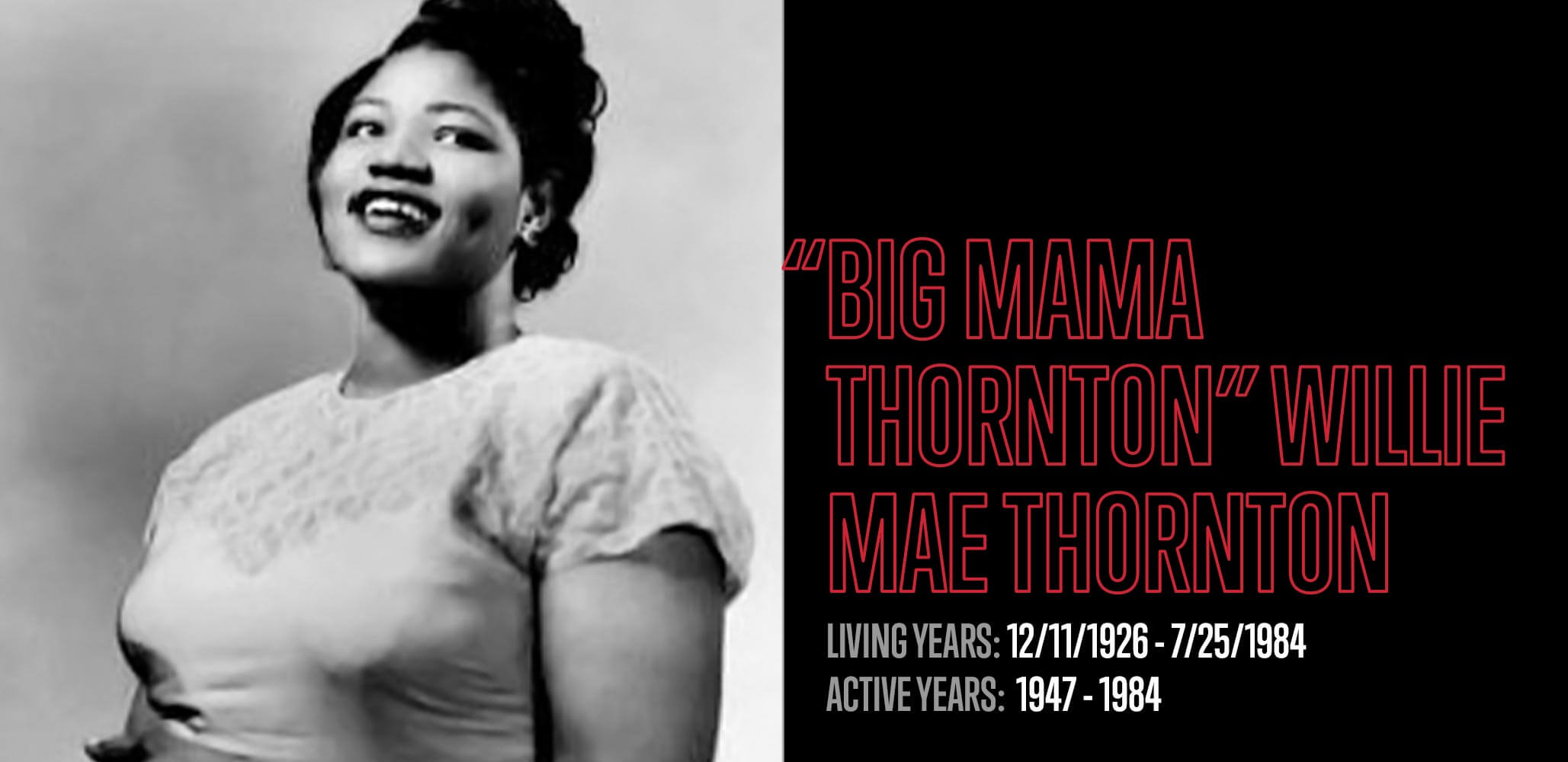
INSTRUMENTS
Vocals, harmonica
GENRES
Blues, R&B, Soul
NOTABLE SONGS
ASSOCIATED ARTISTS/ACTS
Johnny Otis, Muddy Waters, Lightnin' Hopkins, John Lee Hooker, Buddy Guy, Mississippi Fred McDowell
BIOGRAPHY
Big Mama Thornton was a vocalist and Blues songwriter who has been largely under appreciated for her important role in the birth and development of Rock and Roll music. She was born in Alabama as Willie Mae Thornton and grew up singing in her father’s church. Thornton was nicknamed “Big Mama” at the beginning of her career by a manager of The Apollo Theater who was impressed by her immensely powerful voice and her larger-than-life personality.
Thornton’s career took off in 1952 when she recorded the song “Hound Dog”, which was written specifically for her. While Elvis Presley’s later version of this song is more widely known, Big Mama Thornton’s version is hailed as a seminal Rock and Roll performance due to her unbridled and soulful vocals which draw as much from her early Gospel influences as from the Blues.
Thornton later worked with Blues legends such as Buddy Guy, Muddy Waters, and John Lee Hooker, though she never duplicated the popular success of “Hound Dog.” Her career enjoyed a resurgence in the late 1960s when Janis Joplin, a huge admirer, covered Thornton’s original Blues song “Ball and Chain” and offered her an opening slot on tour.
Big Mama Thornton’s career stalled in the late 1970s and early 1980s, as her talents and contributions were overlooked by white audiences and she suffered through health complications brought on by alcohol abuse. She died in 1984. In recent years, more and more music fans have become aware of her work and her legacy as a Blues singer and one of the early pioneers of Rock and Roll music. Aside from her incredible voice, as powerful as anyone’s in popular music history, Thornton was greatly admired by her contemporaries for her unyielding non-conformity and her celebration of body-positivity.
ARTISTS/ACTS THEY INFLUENCED
Elvis Presley, Janis Joplin, Etta James, Koko Taylor
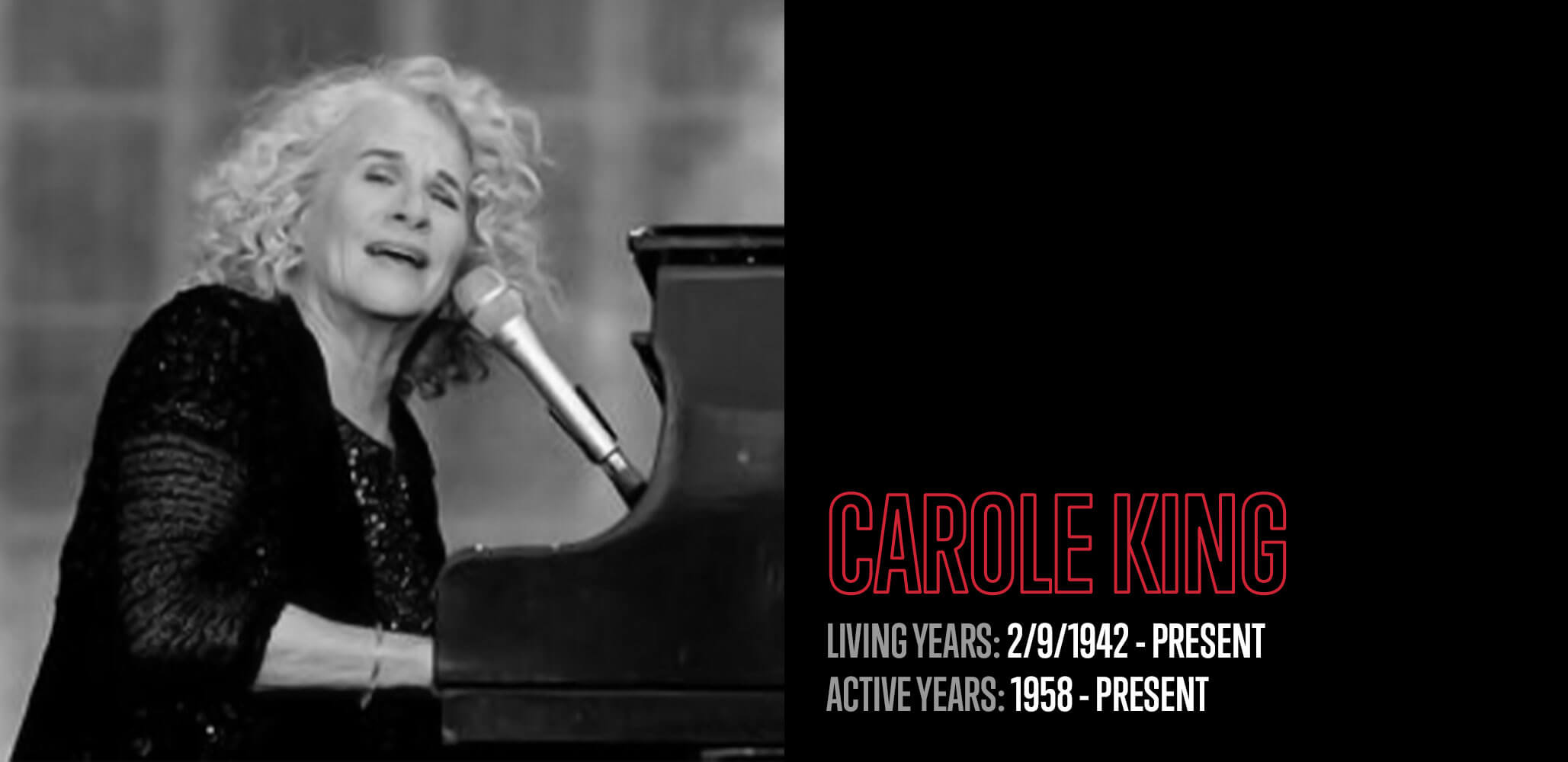
INSTRUMENTS
Vocals, piano, guitar
GENRES
Soft Rock, Pop
NOTABLE SONGS
Will You Love Me Tomorrow?, (You Make Me Feel Like) a Natural Woman, You’ve Got A Friend, It’s Too Late
BIOGRAPHY
Carole King is one of the most prolific female songwriters of the 20th century and had a tremendous influence on pop music as we know it today. She was born Carole Klein in 1942 and raised in Brooklyn, New York; she was an accomplished pianist by 10 and a songwriter in her teens. At 17 she married Gerry Goffin, her romantic and songwriting partner, and they signed a contract with Aldon Music.
Goffin-King worked in the famous Brill Building in NYC alongside established songwriters such as Neil Sedaka, Burt Bacharach, and Leiber and Stoller. They made a name for themselves when their song “Will You Love Me Tomorrow” rocketed the Shirelles to No.1 on the charts, making the Shirelles the first black girl group to reach No. 1. Between 1960 – 1967, King and Goffin wrote an incredible number of chart-toppers recorded by different artists, including the iconic “(You Make Me Feel Like A) Natural Woman” (Aretha Franklin).
In 1968, King moved to Los Angeles after separating from Goffin to pursue personal music projects. She released her masterpiece Tapestry in 1971, breaking records by staying at the top of the Billboard charts for 15 weeks. Her song “It’s Too Late” reached the Billboard No. 1 spot. Tapestry won four Grammys: Album of the Year; Best Pop Vocal Performance, Female; Record of the Year; and Song of the Year (“You’ve Got A Friend”), making King the first woman to win the Song of the Year award. 2021 marked the 50th year since its release, and singer-songwriters and listeners still profess their admiration for King’s vulnerability, confidence, and authenticity in her performance. She gave a voice to women’s struggles in a time that often didn’t allow space for it.
King continued writing and recording music for decades, but she made her significant industry comeback in the 90s when she wrote “The Reason” for Celine Dion in 1997. In the 2000s, King re-recorded “Where You Lead” for the TV show Gilmore Girls. In 2007, she toured Japan with Mary J. Blige and Fergie. In 2010, Carole King and James Taylor embarked on their Troubador Reunion Show to celebrate the 40th anniversary of the first time they played the West Hollywood venue in 1970. Their live album from the tour hit No. 4 on the Billboard charts, cementing King’s position as a prolific figure in the music industry.
All told, King wrote over 118 hit songs. As one of the most successful songwriters, her songs have been recorded by over 1000 artists. Gerry Goffin and Carole King were inducted into the Songwriter’s Hall of Fame in 1987. In 1990, she was inducted into the Rock and Roll Hall of Fame in the non-performer category for her songwriting achievements. In 2013, King became the first woman to be awarded the prestigious Gershwin Prize for Popular Song in a special ceremony at the White House. In 2015, she was honored at the Kennedy Centre for her lifetime contribution to American performing arts, featuring performances by Janelle Monae, James Taylor, Sara Bareilles, and Aretha Franklin.
ARTISTS/ACTS THEY INFLUENCED
Adele, Amy Winehouse, Taylor Swift, Sara Bareilles, Billy Joel, Elton John, Sheryl Crow, Kate Bush, Joe Jackson, Tori Amos
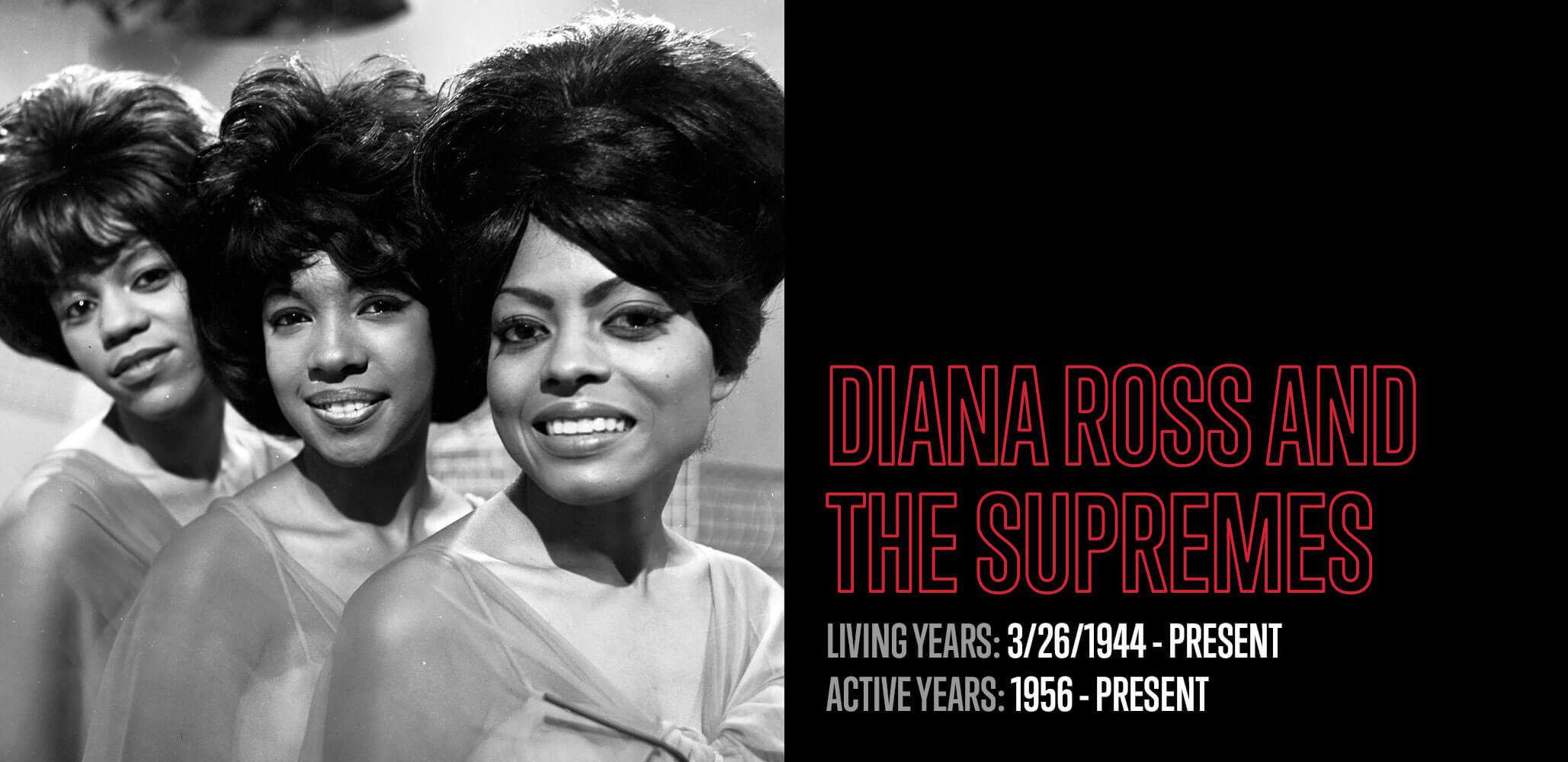
INSTRUMENT
Vocals
GENRES
R&B, Soul, Pop
NOTABLE SONGS
Where Did Our Love Go, Baby Love, Ain’t No Mountain High Enough
ASSOCIATED ARTISTS/ACTS
The Supremes, Michael Jackson
BIOGRAPHY
Diana Ross is one of the most successful female musical artists of all time, scoring number one hits with The Supremes and as a solo artist. Diana Ross and The Supremes were Motown’s most successful act and they were the most successful “Girl Group” of all time.
Born in Detroit, Michigan in 1944, Ross joined an all-girl group the Primettes in 1958. They auditioned for Motown, but label head Berry Gordy thought the girls were too young and still needed to finish high school. In 1961 Berry relented and signed the group but had them change their name to The Supremes. The lineup was Ross, Mary Wilson and Florence Ballard. Initially, all three took turns as the lead vocalist. They released several singles but they failed to gain any traction. In 1963, Gordy decided that Ross should be the lead singer and the focal point of the group.
In 1964, Diana Ross and The Supremes began their domination of the charts. “Where Did Our Love Go” was the first of five consecutive Number One hits followed by “Baby Love”, “Come See About Me”, “Stop (In the Name of Love)” and “Back In My Arms Again”. All five songs were written by the team of Holland-Dozier-Holland, who were the top songwriters and producers for Motown. The next year, The Supremes released three more Holland-Dozier-Holland penned Number Ones: “I Hear a Symphony”, “You Can’t Hurry Love” and “You Keep Me Hangin’ On”.
The Supremes were Motown’s flagship act and their polished look and smooth performances made them popular with both Black and white fans. Gordy groomed The Supremes (and his other acts), presenting them as a full package. In 1967, Gordy also changed the name of the group from The Supremes to Diana Ross and The Supremes. Behind the scenes there was turmoil as Florence Ballard was not accepting her role as a “backup” singer to Ross. Ballard was replaced by one of Patti LaBelle’s back up singers, Cindy Birdsong, in 1967. Tensions within the band and at Motown continued and Ross left The Supremes in 1970.
Diana Ross began a highly successful solo career and she also branched out into film. “Ain’t No Mountain High Enough” was her first solo number one hit. She starred in the film Lady Sings the Blues, based on Billie Holiday’s life story. She continued to have hits, such as her duet with Lionel Richie “Endless Love”, her last number one.
As a member of The Supremes, Ross was inducted into the Rock and Roll Hall of Fame in 1988. Her work with The Supremes and as a solo artist influenced everyone from Michael Jackson to Beyoncé, making her one of the most influential, as well as successful, female artists of all time.
HISTORICAL OR CULTURAL CONTEXT
One of the best-selling female vocal groups of all time
ARTISTS/ACTS THEY INFLUENCED
The Jackson 5, Beyoncé, Mariah Carey
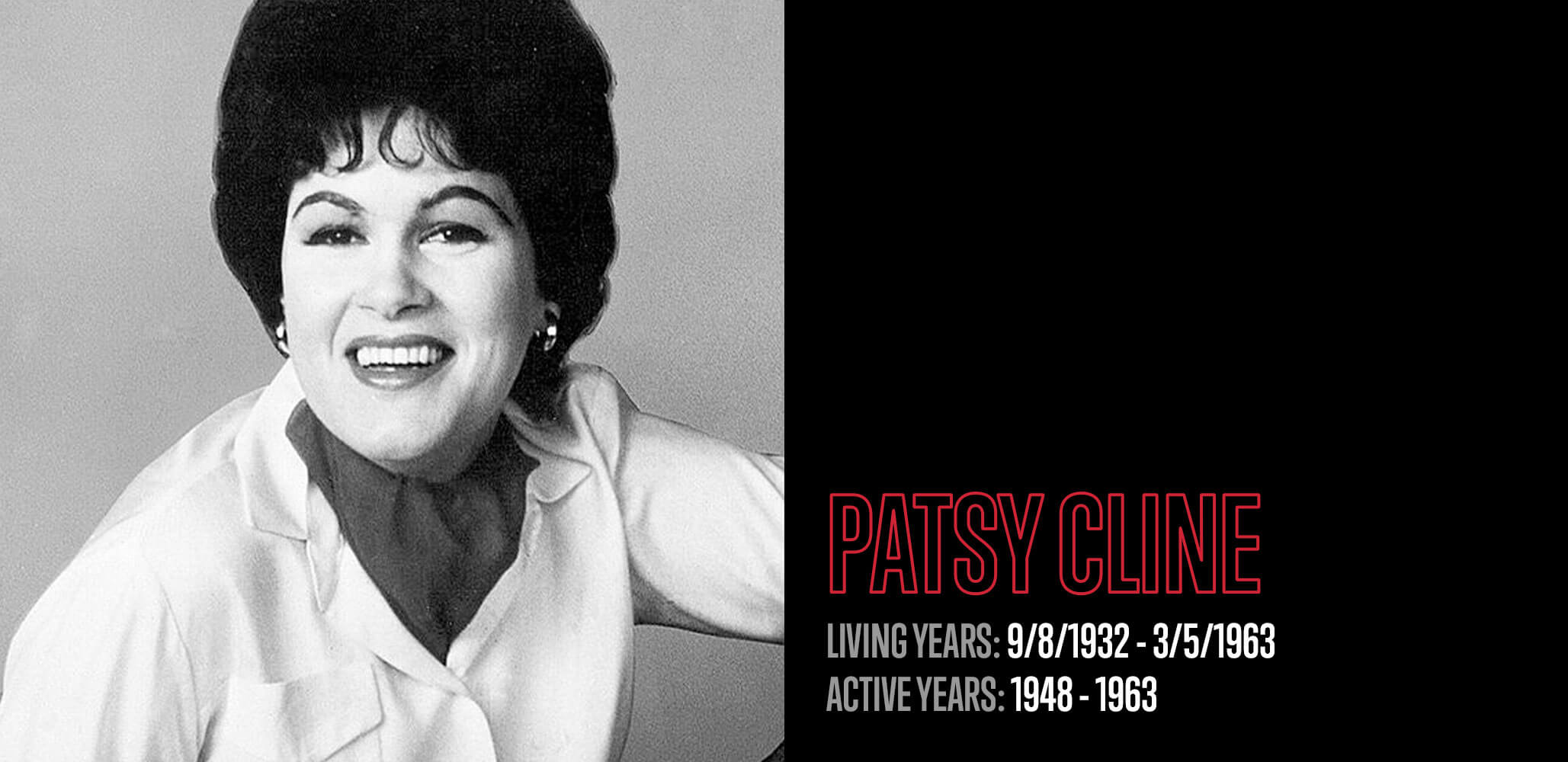
INSTRUMENTS
Vocals, piano
GENRES
Country, Gospel, Honky Tonk, Pop, Rockabilly, the Countripolitan Sound
NOTABLE SONGS
Walkin After Midnight, I Fall to Pieces, Crazy, Sweet Dreams
BIOGRAPHY
Patsy Cline is considered one of the most influential voices of the 20th century. She is also the first artist to make a successful crossover from Country Music to the Pop charts. She had humble beginnings in Virginia and was born into a family of modest means. She played regionally in Virginia in her teens and people took notice of her strong, powerful voice. At the age of 15, she wrote a letter to the Grand Ole Opry asking for an audition. They asked for photos and recordings, which she sent. She got her audition but never heard back.
In 1954, her demo was sent to Four Star Records. They signed Cline to their label and at the time she wasn’t allowed to pick any of the songs she was to record. Cline also only received 2.34% of the royalties from the label. She recorded four singles for the label and none had much success. She continued to perform regionally.
In 1957 she traveled to New York with her mother to appear on the television program, Arthur Godfrey’s Talent Scouts. She met with the producer and presented “A Poor Man’s Roses (Or a Rich Man’s Gold)” as her song. The producer encouraged her to instead perform “Walkin’ After Midnight”. At first Cline declined, but finally agreed to change the song she would perform. The producer also encouraged her to shed her cowgirl look and instead don a cocktail dress. Cline won the contest and “Walkin’ After Midnight hit #2 on the Country charts and #12 on Pop charts almost instantly. She released a full album on the Decca label with little success.
In 1960 Cline moved to Nashville and signed a new management contract with Randy Hughs. While still with Decca, she had more creative control over her song choices and what songwriters she worked with. She also became a member of the Grand Ole Opry. Cline then had many songs chart high on both Country and Pop charts. Notable songs were, “Crazy”, “I Fall to Pieces” and “Sweet Dreams”. She was known for the strength and emotion of her voice and her vocals were often described as haunting, vulnerable and crying.
Patsy Cline died tragically in a plane crash on March 5th, 1963 in Camden, Tennessee due to bad weather alongside other Country greats, Cowboy Copas and Hawkshaw Hopkins. She left behind her two children and husband. Thousands attended her funeral.
Cline’s voice has continued to inspire through the decades. Her confidence, strength and tenacity have lived on.
ARTIST/ACTS THEY INFLUENCED
Reba McEntire, Loretta Lynn, LeeAnn Rimes, KD Lang, Linda, Ronstadt, Trisha Yearwood, Kasey Musgraves, Margo Price, Cyndi Lauper, Brandi Carlile
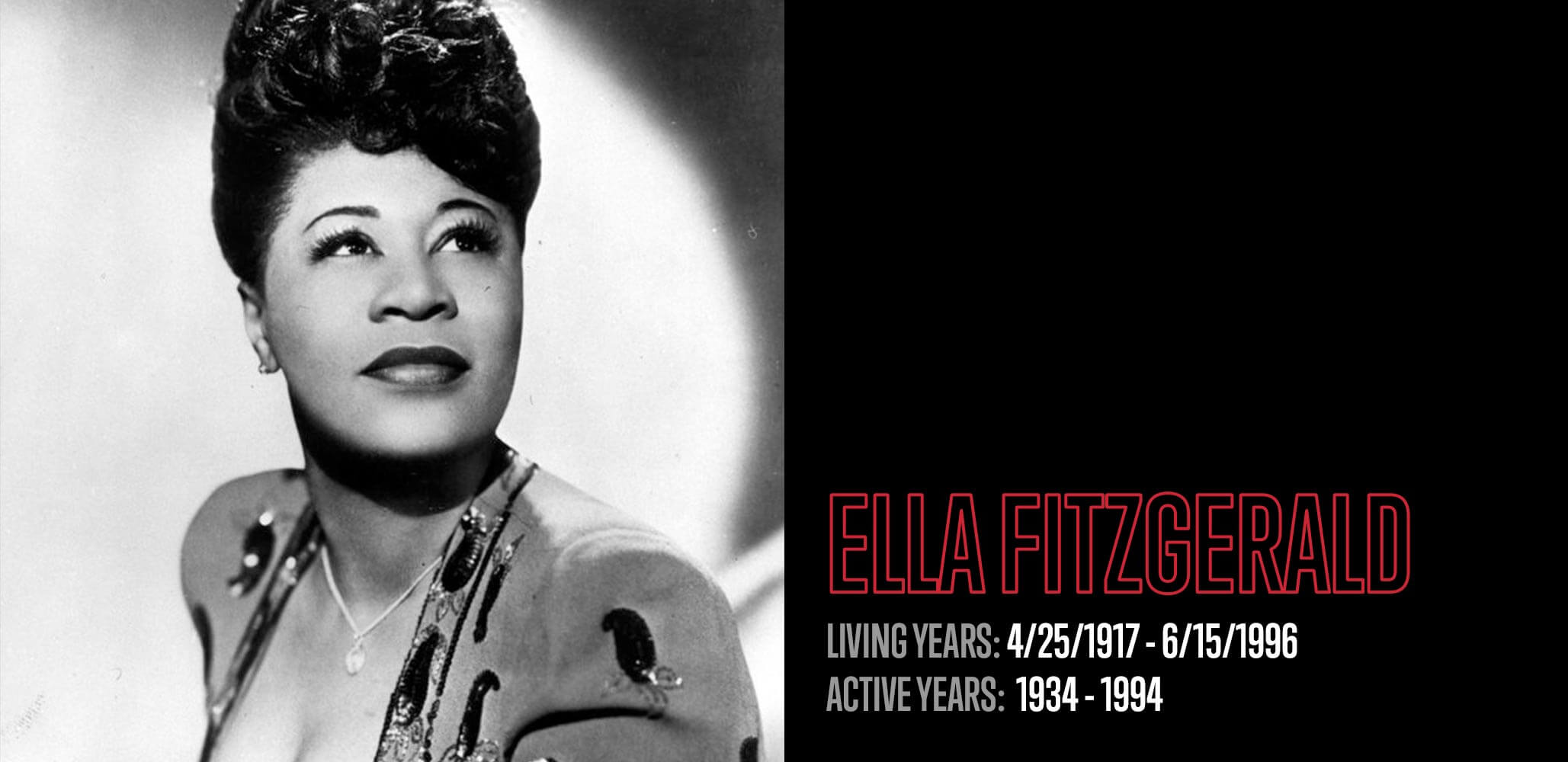
INSTRUMENTS
Vocals
GENRES
Jazz, Bossa Nova, Opera
NOTABLE SONGS
A-Tisket A-Tasket, Into Each Life Some Rain Must Fall
ASSOCIATED ARTISTS/ACTS
Benny Goodman, Louis Armstrong, Duke Ellington, The Mills Brothers, Ink Spots, Dizzie Gillespie, Cole Porter, George Gershwin, Irving Berlin, Johnny Mercer
BIOGRAPHY
Ella Fitzgerald was an American Jazz vocalist frequently referred to as the First Lady of Song. Born in Newport News, Virginia, Ella’s life got off to a rough start. Ella’s father left the family when she was 3 years old, and when she was fifteen her mother died from injuries sustained in a car accident, leaving her stepfather to care for her. It was widely believed that he abused Ella. She later went to live with her Aunt in New York but her behavior landed her in a reform school and the “Colored Orphan Asylum” in the Bronx. Ella got her musical start singing in church, but between the ages of 15 and 18, Ella was homeless and made money by singing on the streets of Harlem.
Ella got her break when Chuck Webb, a young band leader in Harlem, decided that his band needed a female vocalist. He asked Charles Linton, the band’s lead singer, to find him one. Charles Webb did not initially want to listen to Ella because she was not the thin white lead vocalist that he had in mind. Linton had to threaten to quit in order to get Charles Webb to listen to her. Charles gave in and agreed to give her a two week trial period. Ella of course got the gig.
Ella was known for her three-octave range, superb diction, effortless swing, and her ability to scat. She was also known to have “one of the best ears in the business,” resulting in the interesting melodic choices she made and her ability to quickly memorize songs.
Ella made a name for herself in the face of discrimination against women and racism. She also started her career during the Great Depression. She was the first African-American woman to win multiple Grammy Awards. Finally, she was one of the first stars to perform during the Super Bowl Halftime Show in 1972.
Ella has won 14 Grammy Awards, including one for lifetime achievement, as well as a Kennedy Center Honor for lifetime achievement (1979) and the National Medal of Arts (1987). She has influenced countless artists from numerous styles and genres - everyone from Odetta to Adele, from Frank Sinatra to Stevie Wonder. In 2007, the United States Postal Service issued a stamp commemorating Ella Fitzgerald’s contributions to American music and culture.
ARTISTS/ACTS THEY INFLUENCED
Lady Gaga, Amy Winehouse, KT Tunstall, Adele
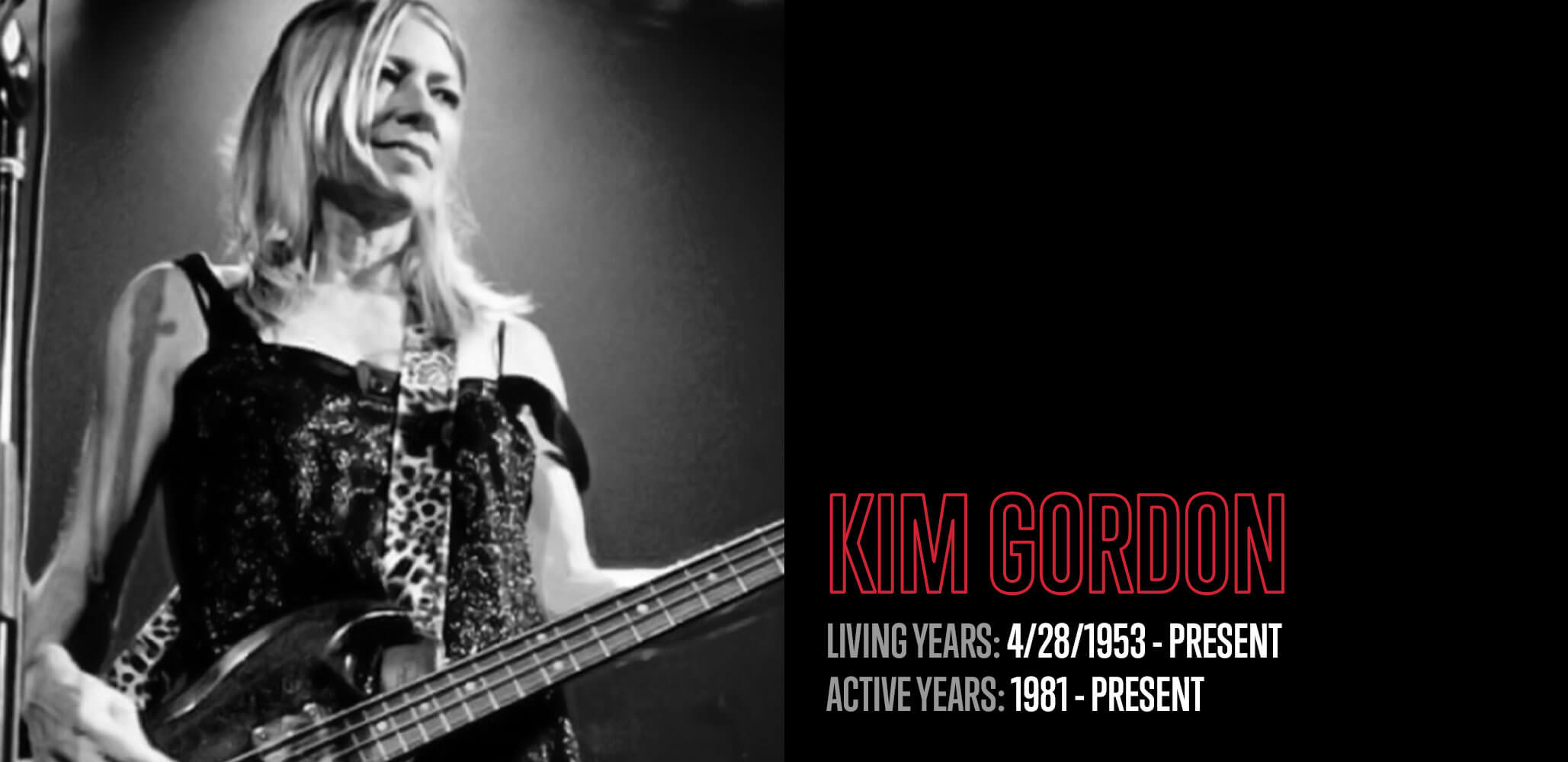
INSTRUMENTS
Guitar, Voice, Visual Art, Fashion
GENRES
Alt Rock, Experimental, Art Rock, No-Wave, Noise Pop, Grunge, Riot Grrrl
NOTABLE SONGS
100%, Kool Thing, Teen Age Riot, Bull In the Heather, Superstar
BIOGRAPHY
Kim Gordon was born in Rochester, NY but was raised in the Los Angeles area from the age of 5. Her father was Dean of Faculty at UCLA and she was able to attend a progressive school associated with the university. She is a graduate of Otis College of Art and Design, where her focus was fine art. She moved to New York City to make her way in the art scene and ended up drawn to the No-Wave music scene that to her, seemed a step beyond punk in that it was really deconstructing rock music and its myths completely. She had never played an instrument before but that was not a detriment in an experimental scene that focused more on playing with notions of noise and melody to break open constructs. The nihilism and freedom of the anti-form were attractive to Gordon and so she picked up a guitar and began exploring her voice as an instrument. In 1981, she formed Sonic Youth with her partner, Thurston Moore, and Lee Ranaldo.
Sonic Youth carved a niche for themselves as innovators and outsider musicians, who wrote beautiful and often haunting melodies that they would layer with noise and feedback that would create its own instrument and atmosphere. The band had a prolific output when combining all 15 studio albums, seven extended plays, 21 singles, three compilation albums, 16 soundtrack appearances, and 46 music videos. Kim Gordon and Thurston Moore were married in 1983 as the band was getting their sound together. They released several small label records and were signed to Punk/Indie giant SST Records in 1986, and put out Evol, which gave them their first critical acclaim, followed by Sister, and then they moved over to Enigma, for whom they recorded the classic and haunting double-LP, Daydream Nation, which was in every very cool kid’s collection in 1988. They made their major-label debut and their first foray into mainstream success with 1990’s Goo, which featured breakout single, “Kool Thing”, a compilation with Public Enemy’s Chuck D. Much of the record deals with female empowerment, pop culture, and the underground music scene that was about to explode. Sonic Youth embarked on a tour in 1991 with Nirvana, Babes In Toyland, Dinosaur Jr, Mudhoney and Gumball. A documentary of the tour potently called, “The Year That Punk Broke”, chronicled the quickly changing popular music scene. Sonic Youth was suddenly thrust into the spotlight as a part of the scene that spawned Grunge and Riot Grrrl. Gordon became known as the epitome of cool and she became a fixture of fashion magazines. She started her own streetwear clothing line, X-Girl. Gordon produced the debut record By Hole (Courtney Love), Pretty On the Inside, and co-directed the video for The Breeders’ hit, “Cannonball’, with Spike Jonez. Sonic Youth put out another two commercially successful albums in quick succession; 1994’s Experimental, Jet Set, Trash, and No Star, which featured lo-fi single “Bull In The Heather” that is one of the finest examples of Kim’s effective and moody-sounding alto, and 1995’s Washing Machine. Gordon was also active with side projects, Harry Crews, Free Kitten and The Supreme Indifference with Jim O’Rourke.
Gordon and Moore split up in 2009 and dissolved Sonic Youth the same year. Gordon began exhibiting paintings again and founded limited-edition fashion label, Mirror/Dash, which was inspired by her daughter (with Moore), Coco. She has appeared as an actor in TV and film projects, including Fred Armisen and Carrie Brownstein’s Portlandia. In 2015, she released a memoir, “Girl In a Band”. Her experimental band, Glitterbust, performs regularly. Gordon’s first solo art exhibition was in 2019 at the Andy Warhol Museum titled, “Kim Gordon: Lo-Fi Glamour. She has inspired countless young women in and out of the music industry and is an icon of pop culture. As Adam Horovitz of the Beastie Boys said, “wherever Kim ends up, she is the coolest person in the room”.
TECHNICAL INNOVATIONS
Sonic Youth famously customized their instruments, amps, and pedals to the point where when their gear was stolen in 1999, they were not able to play their catalog of music the same way ever again.
ARTIST/ACTS THEY INFLUENCED
Courtney Love, Kathleen Hanna, Sofia Coppola (Director), Roisin Murphy
This article was last updated in March, 2021.




